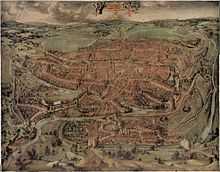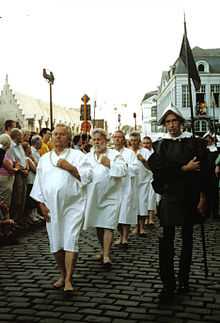Revolt of Ghent (1539)

The Revolt of Ghent was an uprising by the citizens of Ghent against the regime of the Holy Roman Emperor and Spanish King Charles V in 1539. The revolt was a reaction to high taxes, which the Flemish felt were only used to fight wars abroad, in particular the Italian War of 1536–1538.[1] The rebels surrendered without a fight when Charles marched his army into the city the following year. Charles humiliated the rebels by parading them in white undershirts with hangman nooses around their necks. Since then Ghent citizens informally call themselves "noose bearers".
Background
At this time, Ghent was part of the Spanish Empire. Ghent and the Low Countries in general were an international centre of trade and industry and therefore an important source of revenues for Spain. It was subject to the rule of the Holy Roman Emperor and Spanish King Charles V, though it was his sister, Mary of Austria, who actually governed the region as his regent. Ghent had a population between 40,000 to 50,000 people.[2]
In 1515, Charles imposed upon Ghent the Calfvel treaty, which, among other things, prevented the guilds from selecting their own deans. Needless to say, this was very unpopular with the guilds.
In 1536, Charles V went to war with the French king Francis I for control of northern Italy (the Italian War of 1536–1538). Charles asked Mary to raise money and conscripts from the Dutch provinces. In late March 1537, Mary declared a levy of 1.2 million guilders and an army of 30,000 conscripts along with munitions and artillery. Flanders would have to pay a third of this. Ghent was already deep in debt due to fines imposed by its rulers in the previous century.[3]
The revolt
Of the four Dutch provinces, Ghent was the only one to reject the new taxes. The tax was rejected by Ghent's Broad Council, the representative forum for the city's nobles and major guilds. They tore up the calfskin upon which the unpopular 1515 treaty was signed. They also invited 50 day laborers (known as creesers) to sit on the council. The council cited a 1477 treaty (the Great Privilege), no new tax could be imposed on the provinces if they did not unanimously accept it.[4] The other provinces, however, did not join Ghent in rebellion.[5]
Mary tried haggling with the rebels, but to no avail. Mary ordered the arrest of any Ghent citizen found in Brussels or Antwerp.[6]
Charles, in Spain at the time,[7] decided to intervene personally. The French king Francis I, hoping to better his relations with Charles, allowed his army free passage through French territory.[8] Charles moved through France during the winter of 1539. He met with Francis at Loches on December 12, who escorted him to Paris. Moving on, he reached Valenciennes in January, where he met with his sister Mary as well a delegation from Ghent. Charles warned them that he would make an example of Ghent.
Charles reached Ghent on February 14, 1540 with an army of nearly 5,000 soldiers.[9] The city had not expected him to come personally with an army, and offered him no resistance whatsoever as he entered. The leaders of the revolt were arrested, of whom 25 were executed. The rest were to be humiliated: on May 3, they were marched through the streets from the town hall towards Charles' palace, the Prinsenhof. The procession consisted of all the city's sheriffs, clerks, officials, and 30 noblemen dressed in black robes and barefoot; 318 guild members and 50 weavers, they too dressed in black robes; and the 50 day laborers dressed in white shirts with hangman's nooses around their necks.[10][11] The hangman's noose symbolized that they deserved the gallows. At the Prinsenhof, they were made to beg Charles and Mary for mercy.
A fine of 8,000 guilders was imposed on the city.[12] Charles decreed a new constitution, the Caroline Concession, that stripped Ghent of all its medieval legal and political freedoms, as well as all its weapons. The weavers and 53 other crafts guilds were merged into 21 corporations, and the privileges of all guilds save the shippers and butchers were stripped. The old abbey of Saint Bavo's and its church of the Holy Savior were demolished to make way for a new fortress. Eight of the city's gates were permanently closed, and parts of its walls were demolished. The city's aldermen would henceforth be selected by magistrates of the House of Habsburg (Charles' family).[13] Charles also ordered the scaling back of festivals that fostered the city's civic pride.[14]
Legacy
Since this incident the people of Ghent have taken on the sobriquet Stroppendragers (noose bearers). Every summer during the Ghent Festivities, the Guild of Noose Bearers commemorates the revolt by parading through the streets dressed in white shirts with nooses around their neck. The noose has also become an informal symbol of Ghent itself.
 Reenactors marching during the annual Ghent Festival. |
Statue of a noose bearer outside Charles' palace. |
References
- ↑ Kamen, Henry (2005). Spain, 1469–1714: a society of conflict (3rd ed.). Harlow, United Kingdom: Pearson Education. ISBN 0-582-78464-6.
- ↑ OPSTAND IN OUDENAARDE IN 1539-1540 pg 28
- ↑ OPSTAND IN OUDENAARDE IN 1539-1540 pg 48
- ↑ OPSTAND IN OUDENAARDE IN 1539-1540 pg 49
- ↑ Bercé, Y.M. (1987). Revolt and Revolution in Early Modern Europe: An Essay on the History of Political Violence. Manchester University Press. p. 43. ISBN 9780719019678. Retrieved 2014-12-14.
- ↑ "Charles V". renaissance-spell.com. Retrieved 2014-12-14.
- ↑ Society for the Diffusion of Useful Knowledge (Great Britain) (1836). Penny Cyclopaedia of the Society for the Diffusion of Useful Knowledge. C. Knight. p. 500. Retrieved 2014-12-14.
- ↑ http://www.third-millennium-library.com/readinghall/MODERN-HISTORY/REFORMATION/3/3-Ghent.html
- ↑ Tilly, C. (1996). European Revolutions: 1492-1992. Wiley. p. 58. ISBN 9780631199038. Retrieved 2014-12-14.
- ↑ "Historiek | gildevandestroppendragers.be". web.archive.org. Retrieved 2014-12-14.
- ↑ "De Gilde van de Stroppendragers". gentschefieste.be. Retrieved 2014-12-14.
- ↑ OPSTAND IN OUDENAARDE IN 1539-1540 pg 81
- ↑ Arnade, P.J. (1996). Realms of Ritual: Burgundian Ceremony and Civic Life in Late Medieval Ghent. Cornell University Press. p. 263. ISBN 9780801430985. Retrieved 2014-12-14.
- ↑ Arnade, P.J. (2008). Beggars, Iconoclasts, and Civic Patriots: The Political Culture of the Dutch Revolt. Cornell University Press. p. 150. ISBN 9780801474965. Retrieved 2014-12-14.
Bibliography
- "http://gildevandestroppendragers.be/". gildevandestroppendragers.be. Retrieved 2014-12-14.
- "De Gilde van de Stroppendragers". gentschefieste.be. Retrieved 2014-12-14.
- Society for the Diffusion of Useful Knowledge (Great Britain) (1836). Penny Cyclopaedia of the Society for the Diffusion of Useful Knowledge. C. Knight. p. 500. Retrieved 2014-12-14.